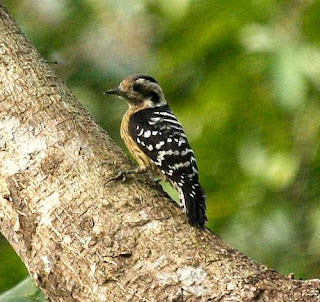The mangrove pitta (Pitta megarhyncha) belongs to the family of pittas, the Pittidae.
The mangrove pitta species is distributed in India, Bangladesh, Myanmar, Thailand, Malaysia, Singapore and Indonesia. These pitta species have fragmented distribution and considered 'Near Threatened' by IUCN. These pittas are monotypic species.
Appearance, physical description and identification
The mangrove pitta is a small mangrove bird, measuring 18 to 20 cm in length and weighing 90 to 120 grams.The adult mangrove pitta has a grayish brown cap with indistinct thin blackish or gray median stripe. There is broad black band from lores to the nape. The chin, throat and the sides of the neck are whitish.
The upperparts, shoulders, mantle, back and wing are dark grayish green. The uppertail is blue. Adults have a large pale greenish-blue glossy patch on the side of the folded wings.
The underparts are yellowish buff and the lower belly, vent and undertail are bright red in adults. The tail is short and stubby. Both the sexes have similar plumage and the juveniles are duller.
The bill is dark gray. The irises are black. The feet are long and are pale grayish pink. Their call is a repeated "wieuw..wieuw" or "oieuw..oieuw" sound.
 |
| 1.Birds of India - Image of Mangrove pitta by Darren Bellerby |
 |
| 2.Indian birds - Picture of Mangrove pitta by Darren Bellerby |
 |
| 3.Birds of India - Photo of Mangrove pitta by Darren Bellerby |
Origin, geographical range and distribution
The mangrove pitta species are distributed in India, Bangladesh, Myanmar, Thailand, Malaysia, Singapore and Indonesia.In India and Bangladesh they occur in the Sundarban Mangroves. In Myanmar, Thailand and Malaysia these species occur on the western coasts. In Sumatra (Indonesia) they are distributed on the eastern coast.
Ecosystem and habitat
These species have moderate forest dependence. They normally occur in altitudes from 0 to 100 meters.The natural ecosystems and habitats of these mangrove species include, tropical and subtropical mangrove forests, tropical and subtropical wetlands, rivers, coastal marshlands, streams, creeks and estuaries.
Diet and feeding behavior
The diet of these birds consists mainly of molluscs. Crustaceans, crabs, beetles, ants, termites, insect larvae are their primary food. They forage on the mangrove forest floor and take rest in trees and shrubs during high tide.Reproduction and breeding habits
The breeding season of the mangrove pitta species is from April to August in Indian subcontinent. In southeast Asia the breeding season is from April to June. These birds are monogamous. Both the pairs take part in nest building, incubation of eggs and care of the young.They build a dome-shaped nest with sticks, dead leaves, grass and coconut fibres on a elevated location on the forest floor. The nest has a side entrance. The female lays 4-5 pale eggs. The chicks hatch out in about two weeks.
Migration and movement patterns
These mangrove pitta species are non-migratory resident birds.Post breeding, the juveniles may disperse and establish in new locations within the range. They may make local movements for feeding and breeding within their range.
Mangrove pitta - Quick Facts
- Scientific name: Pitta megarhyncha
- Species author: Schlegel, 1863
- Synonyms/Protonym: Pitta megarhyncha Schlegel, 1863
- Family: Pittidae › Passeriformes › Aves › Chordata › Animalia
- Vernacular names: English: Mangrove pitta, Chinese: 红树八色鸫, French: Brève des palétuviers, German: Große Blauflügelpitta, Spanish: Pita de manglar, Russian: Мангровая питта, Japanese: マングローブヤイロチョウ, Indonesian: Paok Bakau
- Other names: Larger Blue-winged Pitta, Malay Pitta
- Distribution: India, Bangladesh, Myanmar, Thailand, Malaysia, Singapore, Indonesia
- Diet and feeding habits: crabs, other crustaceans, molluscs, beetles, ants, termites, insect larvae
- IUCN status listing: Near Threatened (NT)
Conservation and survival
The global population size of the mangrove pitta has not been quantified. The overall population trend of the species is considered to be decreasing.Throughout its range, this species is reported to be scarce to locally common. The generation length is 4.2 years. Its distribution size is about 1,680,000 sq.km.
Mangrove habitat alteration and destruction and development of aquaculture facilities along the coast are the main threats that are endangering the survival of this species.
IUCN and CITES status
The mangrove pitta is approaching the thresholds for being Vulnerable under the range size criterion, under the population trend criterion and under the population size criterion.The IUCN (International Union for Conservation of Nature) has categorized and evaluated the species and has listed it as "Near Threatened".
The CITES (Convention on International Trade in Endangered Species of Wild Fauna and Flora) status is ‘Not Evaluated’ for mangrove pitta.
1.Picture source: https://commons.wikimedia.org/wiki/File:Mangrove_Pitta_(18699367178).jpg (cropped)
Picture author: Darren Bellerby | License: CC BY 2.0 as on 10/30/17
2.Picture source: https://www.flickr.com/photos/world-birds/18699376348/ (cropped)
Picture author: Darren Bellerby | License: CC BY 2.0 as on 10/30/17
3.Picture source: https://www.flickr.com/photos/world-birds/18860846486/ (cropped)
Picture author: Darren Bellerby | License: CC BY 2.0 as on 10/30/17
Current topic in Birds of India: Mangrove pitta - Pitta megarhyncha.



















